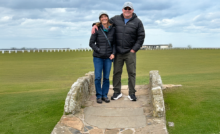The Bear Trace at Harrison Bay install nesting tubes for Mallard Ducks
Golf courses offer many benefits for society and the environment from a place to gather together and play or relax to a filtering system for air and water pollutants to a place for wildlife to live and raise their young. At The Bear Trace at Harrison Bay, an 18-hole Jack Nicklaus Signature golf course located near Chattanooga, Tenn., we work to offer all of these aspects as well as many others. We are always striving to improve the golf course from a conditioning standpoint and an environmental one. That is why I was very pleased when Bill Greene and Mitch Sivley, two of our turf team members, came to me with the idea of constructing and installing nesting tubes for mallard ducks on the golf course.
A mallard duck tends to nest on the ground or in grasses near the water edge, but this nesting practice leaves them vulnerable to predators and other dangers. We have built and installed nesting houses for blue birds and wood ducks over the past years, so this project seemed like a great addition to our environmental stewardship and conservation program. We researched many different nesting tube designs from the Internet and settled on one which created a 36-inch long nesting tube with a 12-inch diameter opening that we felt would be successful.
The design we found used steel to create the support for the nesting tubes but we were concerned with the weight and cost of this material. We chose instead to use PVC piping because it is lightweight, ease to work with, and it is readily available around the golf course maintenance facility.
The nesting tubes themselves are very easy to build and install. The tubes consist of two parts, a 36-inch long nesting tube which will act as housing for the mallard ducks, and the support structure which we called a “cradle.” The cradle is made up starting with a section of 2-inch PVC pipe which will be used to connect the cradle to the post which will be driven into the lake bed. We used a 1.25-inch tee connector in the middle of the cradle with two sections of pipe extending in each direction to reach 36 inches. On each end another tee was used and we reduced the sides of the tee to accept a three-fourths-inch electrical conduit 90-degree fitting.
We ran though a few prototypes before we settled on this design and found it best to run the wire, which is used to secure the nesting tube to the cradle, through the piping before the pieces are glued together. Once the cradle was secured together we applied four different colors of paint to the PVC piping to camouflage it.
With the cradle completed, we next constructed the nesting tubes. The structure of the nesting tube is made up of a 7-foot-long section of common 3-foot-tall coated garden fencing with 2-inch by 3-inch spacing which can be purchased at most home improvement stores or garden centers. The first three feet of the fencing is rolled into a tube which should have a 12-inch diameter and is secured to the remaining fencing with hog rings or wire ties.
Once the center of the tube is secured, the remaining four feet of the wire fencing is covered with a 2- to 3-inch layer of pine straw. Although we used pine straw, you could use flax straw or a straw common to your area, but the use of hay is discouraged as it degrades rapidly and will not serve well over time.
After the layer of pine straw was spread out over the remaining wire fencing, the previously constructed center tube was rolled up over the pine straw. This creates a cylinder of pine straw which is small enough for the mallard duck to get into but not for larger predatory birds to reach and harm them. The ends of the wire fencing should then be secured using hog rings or wire ties. If you choose to construct a nesting tube such as these we suggest you secure each section of interior and exterior fencing together. This will keep the pine straw intact and give the nesting tube greater strength to withstand rain and wind and ducks landing on top of it.
The next step was to place the nesting tube into the nesting cradle and secure the two structures together with the wires which had been inserted through the piping in the beginning. Once completed, it was off to the lake for installation.
The first part of the installation process was to drive steel posts into the lake bed which the 2-inch PVC support tube will be attached to. The nesting tubes need to be about 5 yards out from the bank and at least 3 feet above the water surface. We had several “U” channel road sign posts available, which worked out very well because they already had multiple holes drilled in them, making the attachment of the support tube easier. Bill used a post driver to set the posts into the lake bed, and once the steel post was set, the 2-inch support tube was attached to the post with bolts so that it will be easy to remove and perform maintenance on.
Prior to being installed on the posts, the nesting tubes were filled about two-thirds of the way full with a combination of pine straw and broom sedge harvested from the surrounding area. This material serves as the bedding for the nesting tube to keep the eggs safe and warm. With the bedding in place, the nesting tubes were brought out to the posts and glued onto the support tubes.
The building and installation of the nesting tubes was complete at that point, but to help the conservation project we decided to purchase 10 mallard duck chicks from an online hatchery. The chicks were delivered to the golf course on February 28, 2012, and were kept in the golf course maintenance department building where they were fed, watered, and kept warm using a small heat lamp. It took only a few weeks for the chicks to grow in size and become mallard ducklings.
When the ducklings had gained enough size, Bill constructed a simple holding pen beside the maintenance building parking lot and moved them outside where they could become acclimated to the temperature and weather, and had more room to grow. The ducklings were fed and watered several times per day, and in just a few weeks they were big enough to be transferred to the irrigation lake.
On March 30, Bill moved the ducklings from their holding pen to their new “home” at the irrigation lake. The ducklings were placed in a nesting tube so they would hopefully feel the tubes to be a safe place and fly back up into them when they needed to. It was interesting watching them explore their new environment and get the first taste of true freedom. It is our hope that these ducks will return to this home pond to raise their young in the future.
The nesting tube project is a great addition to our conservation program at The Bear Trace at Harrison Bay, and has already reaped reward with the addition of two pairs of adult mallards taking up residency on the irrigation lake and utilizing a pair of the seven nesting tubes we installed.
We spent parts of two days building and installing the nesting tubes at an investment of only $35.00 per tube. This is a great project which is very simple to do and will provide safe and suitable housing for waterfowl for years to come.
If you would like more information about constructing mallard duck nesting tubes or other environmental stewardship programs at
The Bear Trace at Harrison Bay, please contact me at paul.carter@tn.gov
or 423-344-6374.
Recent Posts
Memphis Country Club: A Golfer’s Study in Precision and Tradition
If you have ever teed it up at Memphis Country Club, you know this isn’t…
Foley Company attains GCSAA Silver Partner Status
Foley Company, a leader in turf equipment innovation and technology, affirms its support of the…
Harrell’s continues longstanding support of the GCSAA Foundation
Harrell’s LLC, a leading distributor of customized agronomic products for turfgrass since 1941, has donated…
City of Orlando Announces New State-of-the-Art Driving Range at Dubsdread Golf Course
The City of Orlando is excited to announce the construction of a brand-new, state-of-the-art driving…
Discover Puerto Rico for Great Golf Trips and After-Round Activities, Amenities
Golfers cannot live by the game alone which is why Puerto Rico provides the perfect…
Q&A with a Multi-talented Golf Course Architect – Part 2: Making the Rounds – Installment 39
This column features recollections of the author’s 37 years as a golf writer. These installments…



